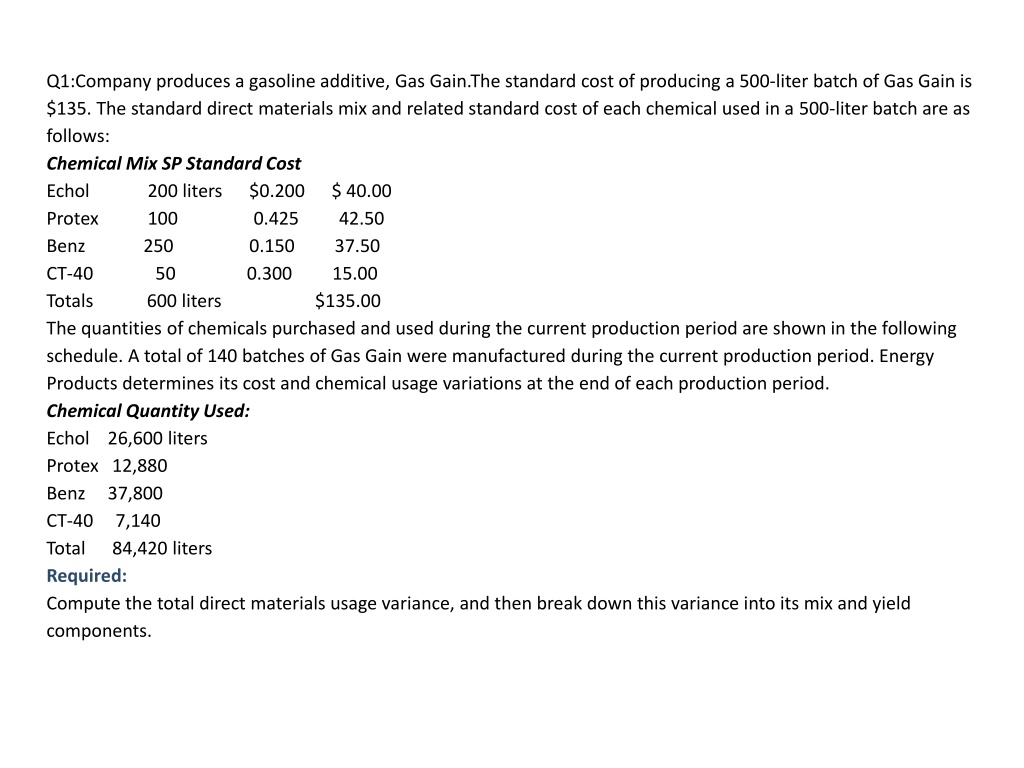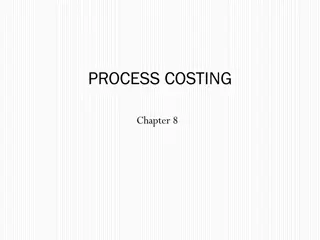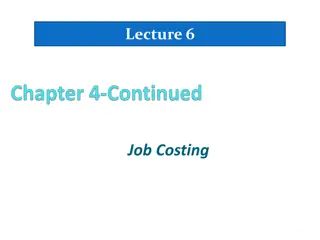Costing and Variance Analysis in Manufacturing Processes
The content discusses various scenarios related to costing and variance analysis in manufacturing processes. It addresses topics such as direct materials usage variance, direct labor mix and yield variances, total direct labor efficiency variance, and standard costing system variances. The examples provided involve calculating variances related to direct materials, direct labor, overhead costs, labor hours, and production units, offering insightful practice in cost control and performance evaluation.
- Costing Analysis
- Variance Calculation
- Manufacturing Processes
- Direct Labor Efficiency
- Standard Costing
Download Presentation

Please find below an Image/Link to download the presentation.
The content on the website is provided AS IS for your information and personal use only. It may not be sold, licensed, or shared on other websites without obtaining consent from the author. Download presentation by click this link. If you encounter any issues during the download, it is possible that the publisher has removed the file from their server.
E N D
Presentation Transcript
Q1:Company produces a gasoline additive, Gas Gain.The standard cost of producing a 500-liter batch of Gas Gain is $135. The standard direct materials mix and related standard cost of each chemical used in a 500-liter batch are as follows: Chemical Mix SP Standard Cost Echol 200 liters $0.200 $ 40.00 Protex 100 0.425 42.50 Benz 250 0.150 37.50 CT-40 50 0.300 15.00 Totals 600 liters $135.00 The quantities of chemicals purchased and used during the current production period are shown in the following schedule. A total of 140 batches of Gas Gain were manufactured during the current production period. Energy Products determines its cost and chemical usage variations at the end of each production period. Chemical Quantity Used: Echol 26,600 liters Protex 12,880 Benz 37,800 CT-40 7,140 Total 84,420 liters Required: Compute the total direct materials usage variance, and then break down this variance into its mix and yield components.
Q2: Limpio, Inc., also uses two different types of direct labor in producing the cleansing chemical: mixing and drum-filling labor (the completed product is placed into 50-gallon drums). For each batch of 20,000 gallons of direct aterials input, the following standards have been developed for direct labor: Direct Labor Type Mix SP Standard Cost: Mixing 2,000 hrs. $11.00 $22,000 Drum-filling 1,000 8.00 8,000 Totals 3,000 hrs. $30,000 Yield 15,000 gallons the actual direct labor hours used for the output produced in March are also provided: Labor Type Mix Mixing 18,000 hrs. Drum-filling 12,000 Total 30,000 hrs. Yield 158,400 gallons Required: 1. Compute the direct labor mix and yield variances. 2. Compute the total direct labor efficiency variance. Show that the total direct labor efficiency variance is equal to the sum of the direct labor mix and yield variances.
Q3: Company uses a standard costing system. During the past quarter, the following variances were computed: Variable overhead efficiency variance $ 30,000 U Direct labor efficiency variance 40,000 U Direct labor rate variance 25,000 U Levram applies variable overhead using a standard rate of $4 per direct labor hour allowed. Two direct labor hours are allowed per unit produced. (Only one type of product is manufactured.) During the quarter, the company used 15 percent more direct labor hours than should have been used. Required: 1. What were the actual direct labor hours worked? The total hours allowed? 2. What is the standard hourly rate for direct labor? The actual hourly rate? 3. How many actual units were produced?
Q4: The Company produces an industrial chemical. At the beginning of the year, the Brownsville plant had the following standard cost sheet: Direct materials (10 lbs. @ $1.60) $16.00 Direct labor (0.75 hr. @ $18.00) 13.50 Fixed overhead (0.75 hr. @ $4.00) 3.00 Variable overhead (0.75 hr. @ $3.00 ) 2.25 Standard cost per unit $34.75 The Brownsville plant computes its overhead rates using practical volume, which is 72,000 units. The actual results for the year are as follows: a. Units produced: 70,000. b. Direct materials purchased: 744,000 pounds at $1.50 per pound. c. Direct materials used: 736,000 pounds. d. Direct labor: 56,000 hours at $17.90 per hour. e. Fixed overhead: $214,000. f. Variable overhead: $175,400. Required: 1. Compute price and usage variances for direct materials. 2. Compute the direct labor rate and labor efficiency variances. 3. Compute the fixed overhead spending and volume variances. Interpret the volume variance. 4. Compute the variable overhead spending and efficiency variances. 5. Prepare journal entries for the following: a. The purchase of direct materials. b. The issuance of direct materials to production (Work in Process). c. The addition of direct labor to Work in Process. d. The addition of overhead to Work in Process. e. The incurrence of actual overhead costs. f. Closing out of variances to Cost of Goods Sold.
Q5: Iverson Company produces microwave ovens. Iversons plant in Akron uses a standard costing system. The standard costing system relies on direct labor hours to assign overhead costs to production. The direct labor standard indicates that four direct labor hours should be used for every microwave unit produced. (The Akron plant produces only one model.) The normal production volume is 120,000 units. The budgeted overhead for the coming year is as follows: Fixed overhead $1,286,400 Variable overhead 888,000* *At normal volume. Iverson applies overhead on the basis of direct labor hours. During the year, Iverson produced 119,000 units, worked 487,900 direct labor hours, and incurred actual fixed overhead costs of $1.3 million and actual variable overhead costs of $927,010. Required: 1. Calculate the standard fixed overhead rate and the standard variable overhead rate. 2. Compute the applied fixed overhead and the applied variable overhead. What is the total fixed overhead variance? Total variable overhead variance? 3. Break down the total fixed overhead variance into a spending variance and a volume variance. Discuss the significance of each. 4. Compute the variable overhead spending and efficiency variances. Discuss the significance of each. 5. Now assume that Iverson s cost accounting system reveals only the total actual overhead. In this case, a three-variance analysis can be performed. Using the relationships between a three- and four- variance analysis, indicate the values for the three overhead variances. 6. Prepare the journal entries that would be related to fixed and variable overhead during the year and at the end of the year. Assume variances are closed to Cost of Goods Sold
Q6: company uses a standard costing system and develops its overhead rates from the current annual budget. The udget is based on an expected annual output of 100,000 units requiring 500,000 direct labor hours. Annual budgeted overhead costs total $437,500, of which $187,500 is fixed overhead. A total of 104,000 units using 540,000 direct labor hours were produced during the year. Actual variable overhead costs for the year were $260,000, and actual fixed overhead costs were $200,000. Required: 1. Compute the fixed overhead spending and volume variances. How would you interpret the spending variance? Which is most appropriate for this example? 2. Compute the variable overhead spending and efficiency variances. How is the variable overhead spending variance like the price variances of direct labor and direct materials? How is it different? How is the variable overhead efficiency variance related to the direct labor efficiency variance?
Q7:company uses a standard costing system and develops its overhead rates from the current annual budget. The udget is based on an expected annual output of 100,000 units requiring 500,000 direct labor hours. Annual budgeted overhead costs total $437,500, of which $187,500 is fixed overhead. A total of 104,000 units using 540,000 direct labor hours were produced during the year. Actual variable overhead costs for the year were $260,000, and actual fixed overhead costs were $200,000. Required: 1. Compute the fixed overhead spending and volume variances. How would you interpret the spending variance? Which is most appropriate for this example? 2. Compute the variable overhead spending and efficiency variances. How is the variable overhead spending variance like the price variances of direct labor and direct materials? How is it different? How is the variable overhead efficiency variance related to the direct labor efficiency variance?
Q8:Dulce Company produces a popular candy bar called Rico. The candy is produced in Costa Rica and exported to the United States. Recently, the company adopted the following standards for one 5-ounce bar of the candy: Direct materials (5.5 oz. @ $0.04) $0.22 Direct labor (0.05 hr. @ $2.60) 0.13 Standard prime cost $0.35 During the first week of operation, the company experienced the following actual results: a. Bars produced: 100,000. b. Ounces of direct materials purchased: 570,000 ounces at $0.045. c. There are no beginning or ending inventories of direct materials. d. Direct labor: 5,200 hours at $2.55. Required: 1. Compute price and usage variances for direct materials. 2. Compute the rate variance and the efficiency variance for direct labor. 3. Prepare the journal entries associated with direct materials and direct labor.























